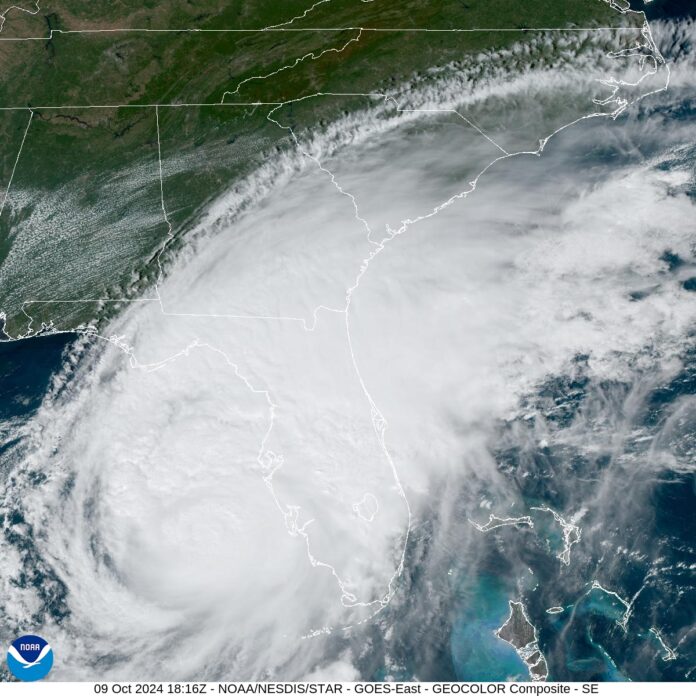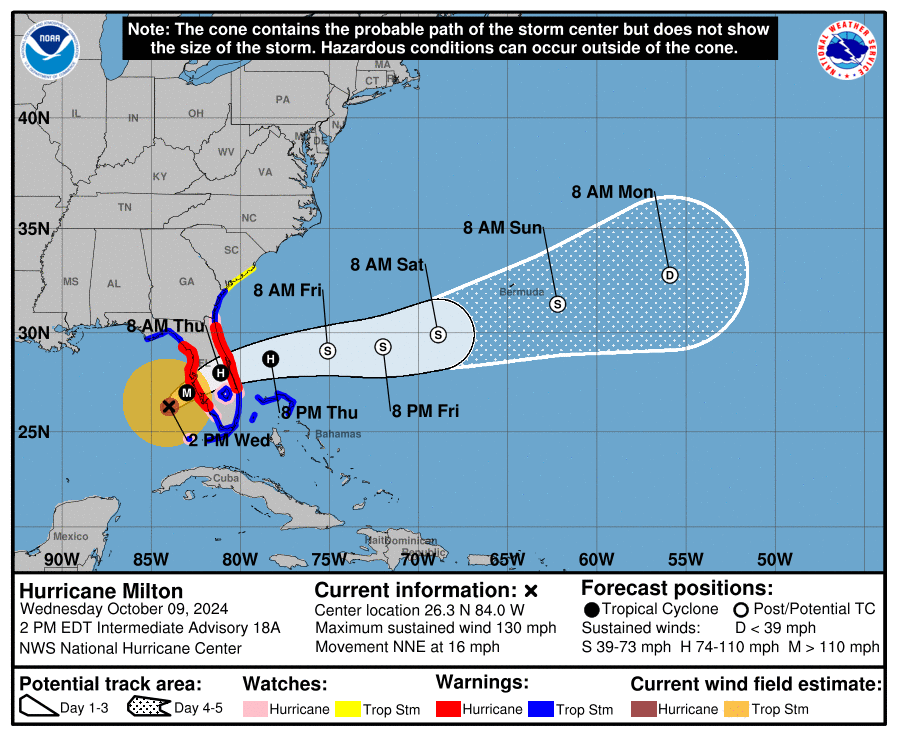
(Florida Phoenix) — Travel conditions have worsened and time to evacuate has mostly run out in areas Hurricane Milton will impact hardest, Florida’s west coast.
The National Hurricane Center update at 2 p.m. indicated Milton is “growing in size as it moves closer to the west coast of Florida.
The center maintains the storm will bring life-threatening storm surge, winds, and flooding in central and southwest Florida.
Maximum sustained winds of the storm were 130 mph Wednesday afternoon, a Category 4.
Tropical storm winds extend up to 250 miles from the center of the storm and hurricane-force winds extend up to 35 miles from the center, according to the National Hurricane Center.
Peak storm surge at the anticipated area of landfall was forecast at 9-13 feet Wednesday afternoon.
During a Wednesday afternoon news conference in Lake City, Gov. Ron DeSantis reminded Floridians on the east coast that damage from winds and storm surge remain a concern.
“Just because the storm is going in on the west coast, that doesn’t mean it’s going to be limited to that. It is going to barrel across the state. You will likely have power outages from the west coast, all the way to the east coast in various parts. You will have some surge on the east coast of Florida, may not be as much as what you get on the west, but I think you’ll see some.”
DeSantis reminded east-coast Floridians to take evacuation orders seriously.

As weather conditions deteriorated Wednesday along Florida’s Gulf Coast, state officials braced for Hurricane Milton, staging resources and encouraging residents of evacuation zones to head to public shelters.
The National Hurricane Center advised at 11 p.m. Wednesday that the time to prepare and evacuate was “quickly coming to an end.”
Milton’s landfall was expected Wednesday night, although tornadic supercells began to hit the Florida peninsula Wednesday morning, the center reported. Multiple tornados were reported.
Storm surge of 10-15 feet was expected in the landfall area, with at least 1-3 feet across the entire west coast of Florida. The storm was producing maximum sustained winds of 145 mph Wednesday morning, keeping it at Category 4.
Local shelters had room, still, according to Director of Emergency Management Kevin Guthrie.
“If you’re making a decision and you say, ‘Oh, it’s too late, there’s not enough room for me.’ There is room. Please come,” Guthrie said during a Wednesday morning news conference.
State government has opened shelters in addition to local facilities, Gov. Ron DeSantis announced. Both can be found on the Florida Division of Emergency Management website. The state shelters are larger in size. These non-school locations have generators and hosting there will enable schools, which also serve as shelters, to reopen to students after the storm more quickly, officials said.
Additional resources, including lists of evacuation orders, state assistance, and more can be found on the website, too.
Bridges and causeways in the area of anticipated landfall were to close in the early afternoon Wednesday, and emergency shoulder use on interstates was to end at noon. Traffic information, including road closures, can be found on FL511.
RELATED Category 4 Milton headed for Florida landfall
Staging
Milton has prompted the largest state preparation effort in more than one metric, according to DeSantis.
The state has deployed 6,000 Florida National Guardsmen, as well as 3,000 from other states.
“This is the largest Florida National Guard search and rescue mobilization in the entire history of the state of Florida,” DeSantis said.
Approximately 50,000 power line workers will be in Florida by the time the storm hits, from as far as California, the governor said. In total, 20 states are assisting Florida, according to DeSantis.
In preparation for Hurricane Milton, landfills were required to stay open 24/7 to dispose of as much debris as possible from Hurricane Helene, which struck Florida two weeks ago.
As of Wednesday morning, the all-out effort to remove debris had stopped. DeSantis said that crews removed about 50% of debris from Hurricane Helene — 3,000 truckloads carrying nearly 55,000 cubic yards of debris.
With the second major hurricane in two weeks, DeSantis thanked the people who have prepared and responded to the storms.
“There’s no better group of people that I would want responding to this than the folks that we have doing it throughout this state,” DeSantis said.
“Whether you’re talking about the counties down on the Gulf Coast of Florida, whether you’re talking about the people that we have here assembled in Tallahassee, these folks have proven themselves. They’re working hard, and we will get the job done.“







